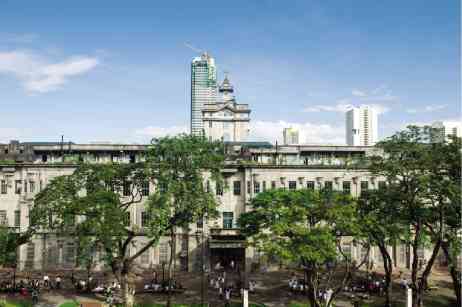Rizal Park
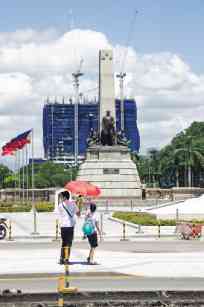
Rizal Park is directly affected by the Torre de Manila condominium project on Taft Avenue.
The Knights of Rizal has filed a petition with the Supreme Court to stop the construction.
Torre de Manila is located on a property where the Art Deco Jai Alai building, designed by National Artist Juan Arellano, used to stand. The toppling of the Arellano edifice was a major conservation issue during the term of Mayor Lito Atienza. It was demolished in 2000 supposedly to give way to a Hall of Justice, which was never erected.
Director Jeremy Barns of the National Museum said in a letter on Aug. 25 to the Senate that the museum was disappointed that the Torre project had been given authorization by the government of Manila.
He pointed out that the building would not only significantly affect the sight line of the Rizal Monument but would also dominate views of Rizal Park and the central complex of the museum itself.
The National Commission for Culture and the Arts agreed. It called on legislators “to consult with our experts and enact appropriate laws to protect the visual and other such vistas that form part of our heritage.”
Rizal Monument has been declared a National Monument and a National Cultural Treasure.
UST
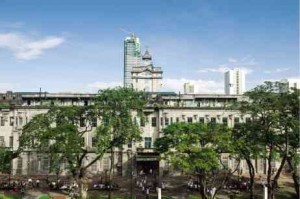
Heritage conservationists are also concerned about the construction of condominium skyscrapers that are ruining the skyline of University of Santo Tomas, declared a National Historical Landmark and National Cultural Treasure.
One prominent building project is Torre de Santo Tomas, built right across the España gate by First Federated Properties, Inc.
“I guess no one really cares about the vista of a place until it’s gone,” said Marjorie Steffi Gaudier, who’s taking up Cultural Heritage Studies at the UST Gradate School.
“They realize everything’s wrong once it’s too late,” added Gaudier, also a faculty member of Colegio de San juan de Letran in Intramuros.
Another threat to UST’s vista is the planned Lacson flyover—a project of DPWH purportedly to ease traffic along Lacson and Espana Streets.
Still another threat would be the plan of DPWH to build a water catchment on the open grounds of the Pontifical University, supposedly to contain flooding around the Sampaloc district.
The proposal by DPWH Secretary Rogelio Singson has raised the eyebrows of the Dominicans who have run UST since 1611. UST insiders say DPWH seems ignorant of the fact that the Philippine government itself has declared the open grounds of UST as a National Cultural Treasure for several historic events that took place there, such as mass assemblies convoked by visiting Popes Paul VI and John Paul II in 1970, 1981 and 1995.
Anda Circle
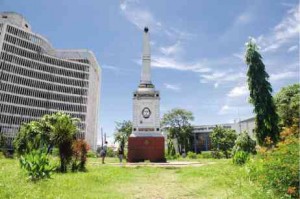
DPWH is set to demolish the historic Anda Circle on Bonifacio Drive ostensibly to give way to an intersection, decongest the street, and protect the monument from heavy vehicles that may crash into and damage it.
Standing at its center is the historic Anda Monument, built in 1871 in honor of Simon de Anda, the Spanish governor general during the British occupation of Manila in 1762-1764. The monument is formerly located near the edge of Pasig River at the head of Malecon Drive, now Bonifacio Drive.
It was moved to its present site in the 1960s when Del Pan Bridge was constructed.
The National Historical Commission of the Philippines (NHCP), with the Intramuros Administration, has agreed to save the monument and transfer it to the Maestranza section of Intramuros.
Wilkie Delumen of the NHCP quoted Article 7 of the Venice Charter of Conservation as the basis for moving the monument: “The moving of all or part of a monument cannot be allowed except where the safeguarding of that monument demands it or where it is justified by national interest of paramount importance.”
Delumen disclosed the NHCP has turned down Manila Councilor Manuel Zarcal’s plan to lessen the size of the rotunda.
Binondo Church
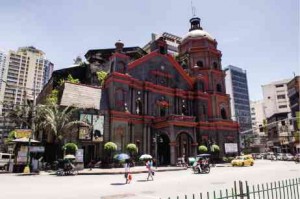
high-rise buildings mar the sight line of the historic church.
Recent work on the Binondo Church façade has raised questions whether it followed correct conservation principles and methods.
The saints on the niches were painted gold while the cornices were painted red. The façade itself was given a “varnish” finish.
The changes didn’t have the approval of NHCP, said Delumen.
Binondo Church, also known as the Minor Basilica of San Lorenzo Ruiz de Manila, was built in the late 1600s. It was destroyed during World War II, in which only the façade, including the belfry and the Ongpin Street side, remained standing. It was reconstructed after the war.
The church was declared a Historical Site in 1972 by the National Historical Commission.
Manila Bay
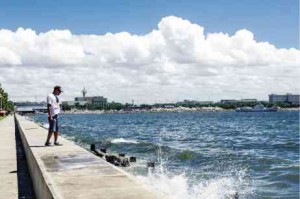
Another issue hounding Manila is the Manila Bay Reclamation Project.
Manila City Hall, under Mayor Alfredo Lim, had passed an ordinance allowing the reclamation of the bay area, which was said to benefit a casino developer.
Earlier, Pasay City Hall had also passed an ordinance allowing further reclamation of the already reclaimed area in its jurisdiction, apparently also to benefit a casino developer.
Both reclamation projects surprisingly were given clearance by the Department of Environment and Natural Resources.
Recently a big conglomerate has also proposed reclamation to build a new international airport.
Malate Church, environmentalists, and heritage advocates are wary of the environmental impact the project may cause. They say the reclamation would affect the sight line of the historic bay.
“No to reclamation!” said Heritage Conservation Society head Gemma Cruz-Araneta.
In 2012, NHCP declared the Manila Bay waterfront, from Del Pan Bridge to the Cultural Center of the Philippines, a National Historical Landmark.

